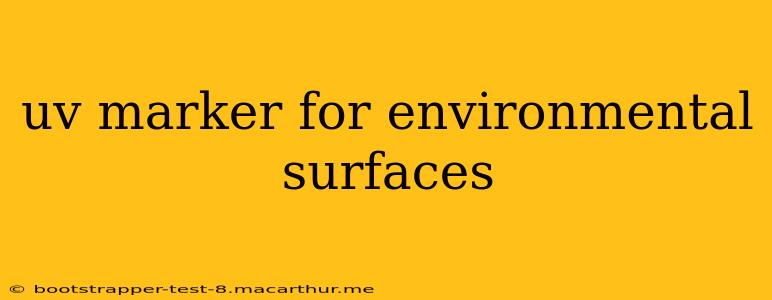UV markers, also known as ultraviolet markers or blacklight markers, are specialized marking pens that contain inks invisible under normal lighting conditions but glow brightly under ultraviolet (UV) light. Their unique properties make them invaluable tools in a variety of applications, particularly in environmental monitoring and research. This guide delves into the uses of UV markers for environmental surfaces, exploring their benefits, limitations, and considerations for effective application.
What are UV Markers Used For on Environmental Surfaces?
UV markers find extensive use in various environmental settings due to their non-invasive nature and ability to leave a lasting, yet easily detectable, mark. Their applications range from marking wildlife for tracking studies to identifying specific areas for sampling or monitoring. Here are some key applications:
- Wildlife Tracking and Research: Researchers utilize UV markers to tag animals and track their movements, providing crucial data for conservation efforts. The non-toxic nature of many UV inks ensures minimal impact on the animals.
- Environmental Monitoring and Sampling: UV markers can help scientists and researchers clearly identify sampling locations, preventing confusion and ensuring data accuracy in environmental monitoring projects. This is crucial for consistency in long-term studies.
- Erosion and Sediment Studies: Marking specific points on surfaces prone to erosion allows researchers to track changes over time, providing valuable insights into erosion rates and patterns.
- Forensic Investigations in Environmental Crime: UV markers can aid in documenting evidence related to environmental crimes, such as illegal dumping or poaching.
- Plant Studies and Botany: Researchers may use UV markers on plants to track growth patterns, disease spread, or the impact of environmental factors.
What Types of UV Markers are Best for Environmental Surfaces?
The choice of UV marker depends heavily on the specific application and the type of surface being marked. Several factors need consideration:
- Ink Durability: Some UV inks are more resistant to fading from sunlight and weathering than others. For long-term outdoor applications, choosing a highly durable ink is essential.
- Surface Compatibility: Different inks adhere better to certain materials. Consider whether you're marking rock, wood, vegetation, or other surfaces. Test a small area before widespread application to ensure proper adhesion.
- Toxicity: For use with wildlife or in sensitive ecosystems, non-toxic, environmentally friendly inks are paramount. Always check the manufacturer's specifications before use.
- Wavelength Specificity: UV inks emit fluorescence at specific wavelengths. Ensure your UV light source is compatible with the chosen marker's ink.
What are the Limitations of Using UV Markers on Environmental Surfaces?
While UV markers offer many advantages, certain limitations exist:
- UV Light Availability: Effective detection requires a reliable UV light source. In field settings, this might necessitate carrying a dedicated UV lamp.
- Fading: Even the most durable UV inks can fade over time, especially with prolonged sun exposure. Regular re-marking might be necessary for long-term studies.
- Environmental Factors: Extreme weather conditions, such as heavy rainfall or extreme temperatures, can affect ink durability and visibility.
- Surface Texture: Rough or porous surfaces may not allow for even ink application or might absorb the ink, reducing visibility.
Are UV Markers Safe for the Environment?
The safety of UV markers for the environment depends entirely on the ink composition. Many manufacturers offer non-toxic, biodegradable inks suitable for use in ecologically sensitive areas. However, it's crucial to verify the ink's safety profile with the manufacturer before application, particularly when working with wildlife or in protected environments. Always choose inks explicitly labeled as environmentally safe.
How Long Do UV Markers Last on Environmental Surfaces?
The longevity of UV marker markings varies depending on several factors, including ink type, environmental conditions, and the surface being marked. Some inks can last for several weeks or months, while others may fade within days or weeks. To maximize longevity, opt for weather-resistant inks and consider re-marking periodically for long-term studies.
What are Some Examples of UV Markers Used in Environmental Studies?
Numerous studies utilize UV markers for various environmental applications. For example, researchers might use them to mark nesting sites of endangered birds, track the movement of migrating animals, or monitor the spread of invasive plant species. The specific marker type and ink chosen depend heavily on the study's objectives and the environment being studied.
This comprehensive guide provides a deeper understanding of UV markers and their role in environmental applications. Remember always to prioritize safety and environmental responsibility when utilizing these tools. Choosing the appropriate marker and adhering to best practices ensures accurate data collection and minimal environmental impact.
